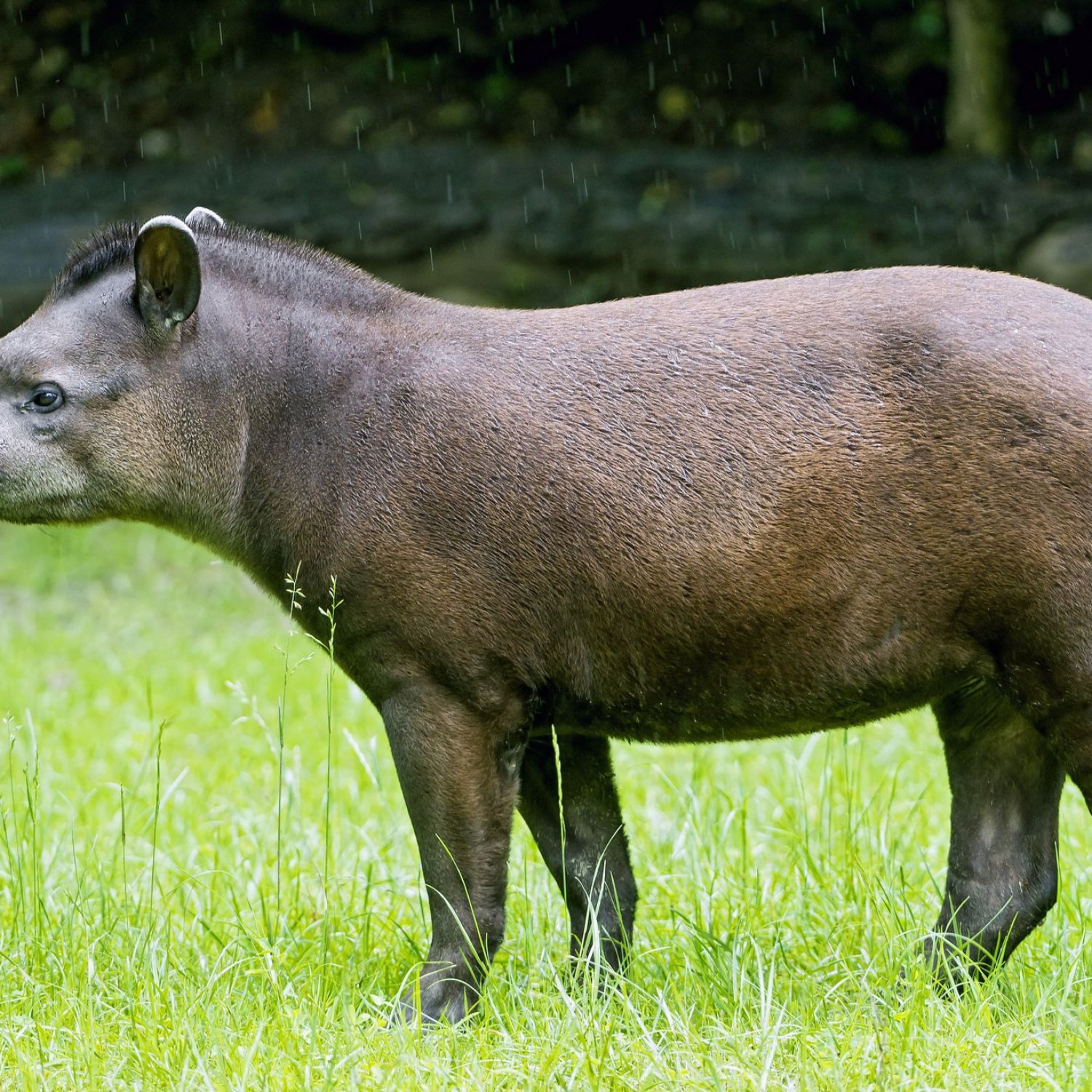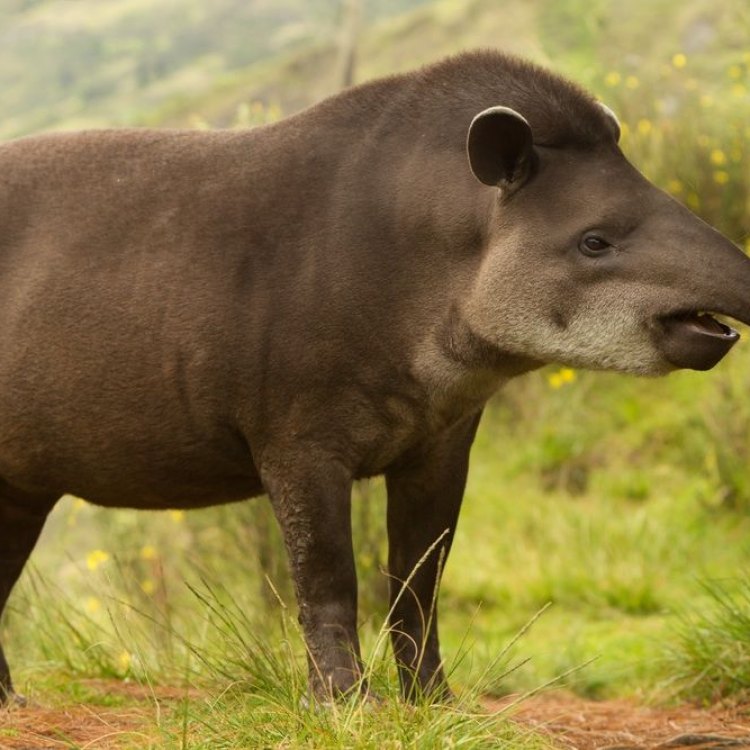
Tapir
6 to 8 feet
The tapir, found in rainforests, is a unique animal with a large, stocky body, short neck, short tail, and a long, flexible proboscis. They can grow up to 6-8 feet long and are part of the Tapiridae family. These gentle herbivores are important for maintaining the balance of their ecosystem. #Tapir #Rainforest #Wildlife
Animal Details Summary:
Common Name: Tapir
Kingdom: Animalia
Habitat: Tropical and subtropical forests, grasslands, and wetlands
The Strange and Fascinating World of the Tapir
The rainforests of Brazil are home to a creature that has captivated the attention of scientists and animal lovers alike – the tapir. With its large, stocky body, short tail, and long, flexible proboscis, the tapir is a unique and intriguing animal. Often referred to as a “living fossil,” the tapir has remained relatively unchanged for millions of years, making it a truly remarkable creature.But what exactly is a tapir? Where can you find them? And why are they facing threats that could potentially lead to their extinction? In this article, we’ll dive into the fascinating world of the tapir, exploring its physical attributes, habitat, behavior, and conservation status Tapir.
The Basics: What is a Tapir?
Scientifically known as Tapirus, the tapir is a mammal that belongs to the order Perissodactyla, which means “odd-toed ungulates.” This diverse order also includes horses, zebras, and rhinoceroses. Tapirs are further classified into four species: the Brazilian tapir, the Malayan tapir, the Baird’s tapir, and the mountain tapir. They are found in Central and South America, as well as Southeast Asia.Featuring a large and stocky body, tapirs have a short neck and a short, stubby tail. Their most distinctive feature is their long, flexible proboscis, which resembles a shortened version of an elephant’s trunk. Their bodies are covered in short, coarse hair that ranges in color from black to gray to reddish-brown, depending on the species. They also have large, rounded ears and small, beady eyes.
Where Can You Find Tapirs?
Tapirs are found in a wide range of habitats, from tropical and subtropical forests to grasslands and wetlands Tully Monster. They are predominantly solitary animals and are mostly active at night, making them hard to spot in the wild. As they need access to water to survive, they are often found near rivers, streams, and other water sources.The four species of tapir are typically found in different parts of the world. The Brazilian tapir is primarily found in the Amazon rainforest, while the Malayan tapir is found in the dense tropical forests of Southeast Asia. The Baird’s tapir is found in Central America, and the mountain tapir can be found in the mountainous regions of South America.
An Odd Diet: What Do Tapirs Eat?
Unlike their hoofed relatives in the order Perissodactyla, tapirs are herbivores. They have a specialized diet consisting of fruits, leaves, and other vegetation. Their long, flexible proboscis helps them to grasp and manipulate food, making it easier for them to reach fruits and leaves from high branches. They are also able to swim and can dive to the bottom of rivers to forage for aquatic plants.Interestingly, tapirs are also known for their ability to disperse seeds through their feces, making them an important part of the ecosystem. As they move through the forest, tapirs eat fruits and scatter the seeds throughout the forest floor, helping to ensure the growth and diversity of plants in their habitat.
The Threats Facing Tapirs
Despite their crucial role in maintaining the balance of their ecosystem, tapirs are facing numerous threats that could potentially lead to their extinction. Habitat loss due to deforestation is a major issue for tapirs, as it reduces their access to resources and forces them into smaller and more fragmented habitats.Poaching and hunting are also major threats that tapirs face. In some areas, tapirs are killed for their meat, which is considered a delicacy in some cultures. They are also hunted for their skin, which is used to make traditional clothing and accessories. Additionally, tapirs often fall victim to collisions with vehicles as roads and highways cut through their habitat.
Conservation Efforts and Future Prospects
Fortunately, there are efforts in place to protect tapirs and their habitat. In Brazil, the government has implemented protected areas, such as national parks and reserves, to preserve the habitats of tapirs and other endangered species. Various organizations and conservation groups are also working to raise awareness about tapirs and the threats they face and are implementing projects to protect their populations.Some positive news for tapirs is that their populations in Brazil and other parts of their range are stable or even increasing. However, the situation is still concerning as some species, such as the mountain tapir, have small populations and are considered vulnerable to extinction. Continued efforts are crucial to ensuring the survival of these unique and important animals.
In Conclusion
The tapir may not be as well-known as its larger and more famous relatives like elephants and rhinoceroses, but it plays a vital role in its ecosystem. With its curious appearance and surprising behaviors, the tapir is a fascinating and often overlooked creature. From its flexible proboscis to its herbivorous diet, there is much to learn and appreciate about this “living fossil.”But as human activities continue to threaten their existence, it is up to us to take action and protect tapirs and their habitats. By supporting conservation efforts and spreading awareness about these unique animals, we can ensure that future generations will be able to admire and appreciate the strange and wonderful world of the tapir. So, let’s remember to do our part in preserving the diverse and precious creatures that call our planet home.

Tapir
Animal Details Tapir - Scientific Name: Tapirus
- Category: Animals T
- Scientific Name: Tapirus
- Common Name: Tapir
- Kingdom: Animalia
- Phylum: Chordata
- Class: Mammalia
- Order: Perissodactyla
- Family: Tapiridae
- Habitat: Tropical and subtropical forests, grasslands, and wetlands
- Feeding Method: Herbivorous
- Geographical Distribution: Central and South America, Southeast Asia
- Country of Origin: Brazil
- Location: Rainforests
- Animal Coloration: Varies by species, ranging from black to gray to reddish-brown
- Body Shape: Large, stocky body with a short neck, short tail, and long, flexible proboscis
- Length: 6 to 8 feet

Tapir
- Adult Size: Up to 3.5 to 6.2 feet (shoulder height)
- Average Lifespan: 25 to 30 years
- Reproduction: Viviparous
- Reproductive Behavior: Solitary or monogamous
- Sound or Call: High-pitched whistle or squeal
- Migration Pattern: Non-migratory
- Social Groups: Solitary or small family groups
- Behavior: Nocturnal and crepuscular
- Threats: Habitat loss, hunting, and illegal wildlife trade
- Conservation Status: Vulnerable
- Impact on Ecosystem: Seed dispersers
- Human Use: Hunted for meat and other body parts
- Distinctive Features: Long, flexible proboscis and distinctive black and white markings on the face and body
- Interesting Facts: Tapirs are excellent swimmers and can submerge themselves in water to escape predators
- Predator: Jaguars, crocodiles, and large birds of prey

Tapirus
The Fascinating World of Tapirs: Mysterious Creatures of The Rainforest
Deep in the heart of the rainforest, hidden behind lush foliage and dense undergrowth, lies a creature shrouded in mystery – the tapir. With their unique features and solitary nature, these elusive animals have captured the imagination of scientists and wildlife enthusiasts alike. In this article, we will delve into the fascinating world of tapirs, exploring their behavior, threats, and impact on their ecosystem.What is a Tapir?
Tapirs are large, herbivorous mammals that belong to the order Perissodactyla, which also includes horses and rhinoceroses PeaceOfAnimals.Com. They are found in the tropical forests of Central and South America, as well as in Southeast Asia.
The name 'tapir' is derived from the indigenous Tupi language, and it means "thick" or "plump". With their stout bodies and short legs, tapirs certainly live up to this name. They have a stocky build, with a small head, short neck, and rounded ears. Their most distinctive feature is their long, flexible snout – also known as a proboscis – which is used for foraging and plucking leaves and fruits.
Size and Lifespan
Adult tapirs can grow to be between 3.5 to 6.2 feet (shoulder height), making them one of the largest land mammals in their habitat. They can weigh anywhere between 440 to 750 pounds, with females being slightly larger than males Tiktaalik.
On average, tapirs can live up to 25 to 30 years in the wild, although there have been reports of individuals living up to 35 years in captivity. They are considered to be long-lived animals, with a slow reproduction rate, which makes them highly vulnerable to threats such as habitat loss and hunting.
Reproduction and Social Behavior
Tapirs are viviparous, which means they give birth to live young rather than laying eggs. Females typically give birth to one calf at a time, which they nurse for around a year before being fully weaned. They reach sexual maturity at around two or three years of age.
These solitary creatures may sometimes form small family groups, consisting of a mother and her offspring. Male tapirs, however, are mostly solitary and are known to be territorial. In some cases, they have been observed to form monogamous pairs with a female, although this behavior is not common.
Sounds and Calls
Tapirs are not known for their vocal abilities, but when they do make sounds, they produce high-pitched whistles or squeals. These vocalizations are most commonly heard during the mating season or when a mother is communicating with her calf.
Migration and Behavior
Unlike other animals, tapirs do not have a defined migration pattern. They are non-migratory and tend to stay within a range of a few miles, mostly confined to dense forested areas. They are also mainly active during the night and early morning, making them nocturnal and crepuscular animals.
As for their behavior, tapirs are known for being shy and avoiding humans. They are excellent swimmers and can often be found near water sources, where they can submerge themselves to escape potential predators.
Threats and Conservation Status
Despite being elusive, tapirs are facing significant threats to their survival. The loss of their habitat due to deforestation, agricultural expansion, and human settlement has significantly impacted their populations. These animals are also hunted for their meat and other body parts, which are used in traditional medicine or as curios. The illegal wildlife trade is a severe threat to their survival, especially in Southeast Asia.
Due to these threats, tapirs are listed as vulnerable on the International Union for Conservation of Nature (IUCN) Red List. This means that their survival is at risk, and urgent action is needed to protect them from extinction.
Impact on the Ecosystem
Despite their solitary nature, tapirs play a crucial role in their ecosystem and have a significant impact on the balance of their habitat. As herbivores, they are responsible for dispersing seeds, which helps in plant regeneration and diversity. Their long proboscis enables them to reach fruits and seeds from trees that other animals cannot, making them important seed-dispersers.
Moreover, tapirs are considered a keystone species – which means they have a disproportionately large effect on their environment compared to their abundance. They are often called "gardeners of the forest" due to their habit of clearing small sections of the forest floor while foraging. This behavior contributes to the growth of new plants and helps maintain a healthy ecosystem.
Human Use
Unfortunately, humans have exploited tapirs for their own use. These animals have been hunted for centuries for their meat, which is considered a delicacy in some regions. Some indigenous communities also use their body parts for medicinal purposes, and their hides are often used as rugs or decorations.
However, responsible tourism has emerged as a potential solution to support the conservation of tapirs. Ecotourism activities focused on these mysterious animals can help raise awareness about their significance and contribute to local conservation efforts.
Distinctive Features
Tapirs are easily recognizable due to their unique black and white markings on their face and body. The patterns are different for each tapir, making them easily identifiable. These markings serve as camouflage, blending in with the dappled light of the forest floor.
Apart from their distinctive markings, tapirs also have adapted features that make them well-suited for their environment. For instance, their eyes and ears are located high on their heads, which allows them to remain completely submerged in water while foraging for food. Their feet also have four padded toes, which help them navigate uneven terrain and muddy surfaces.
Interesting Facts
Tapirs are full of surprises, and despite being elusive, researchers have uncovered some fascinating facts about these mysterious creatures. Did you know that tapirs are excellent swimmers and can hold their breath for up to 5 minutes? They can also dive deep into the water, submerging themselves to escape predators.
Another interesting fact is that tapirs have a prehensile upper lip, which they use to grab and eat leaves and fruits from trees. It is also believed that this unique feature helps tapirs sense and locate food in the dark, as they are mostly active at night.
Predators
As prey animals, tapirs have a few natural predators in their habitat. They are often targeted by large cats, such as jaguars and pumas, as well as crocodiles and large birds of prey. However, their elusive and elusive nature makes them difficult to hunt, making them a less desirable target for most predators.
The Future of Tapirs
The future of tapirs is uncertain, and without urgent action, these magnificent animals could face extinction. The loss of their habitat, along with hunting and illegal trade, is putting immense pressure on their populations. However, conservation efforts and responsible tourism can make a significant impact in safeguarding the survival of tapirs.
By raising awareness and supporting conservation initiatives, we can ensure that tapirs continue to thrive in their natural habitat and play a vital role in their ecosystem. Let us join hands in protecting these mysterious creatures of the rainforest before it is too late.

The Strange and Fascinating World of the Tapir
Disclaimer: The content provided is for informational purposes only. We cannot guarantee the accuracy of the information on this page 100%. All information provided here may change without prior notice.












